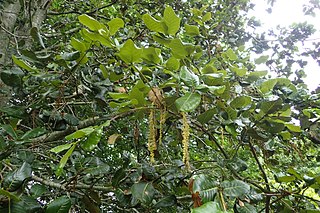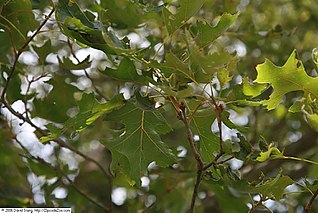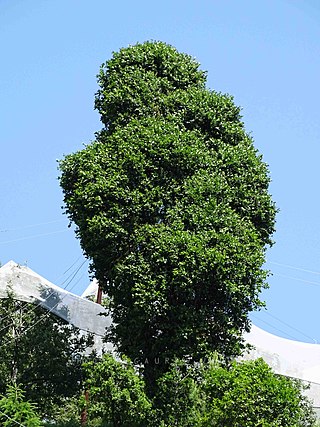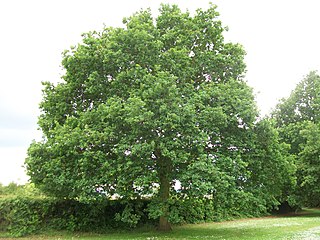Quercus macdougallii is a species of plant in the family Fagaceae. It is placed in section Quercus.

Quercus franchetii, commonly known as the zhui lian li evergreen oak, is a species of oak in the Ilex section of the genus, native to a wide area of eastern Asia. It is an oak native to China, northern Thailand and Vietnam, growing at altitudes between 800 and 2,600 metres.

Quercus phillyreoides is a species of flowering plant in the genus Quercus, placed in subgenus Cerris and section Ilex. It is evergreen, withstands frost and can be grown in hardiness zone 7. It is native to southern China, the Ryukyu Islands, and Japan, and has been introduced to Korea.

Quercus semecarpifolia is an Asian species of oak. It is native to the Himalayas and nearby mountains in Tibet, Afghanistan, India, Nepal, and Pakistan, where it is referred to as kharsu. It is classified in subgenus Cerris, section Ilex.
Quercus austrocochinchinensis is an uncommon species of tree in the beech family Fagaceae. It has been found in Vietnam and Thailand as well as Yunnan Province in southern China. It is placed in subgenus Cerris, section Cyclobalanopsis.
Quercus chevalieri is an uncommon species of tree in the beech family Fagaceae. It has been found in Vietnam and also in southern China, in the Provinces of Guangdong, Guangxi, and Yunnan. It is placed in subgenus Cerris, section Cyclobalanopsis.
Quercus gambleana is a species of tree in the beech family Fagaceae. It has been found in northeastern India and southwestern China. It is placed in subgenus Cerris, section Cyclobalanopsis.
Quercus kouangsiensis is an uncommon Asian species of trees in the beech family Fagaceae. It has been found only in southern China, in the Provinces of Guangdong, Guangxi, Hunan, and Yunnan. It is placed in subgenus Cerris, section Cyclobalanopsis.
Quercus saravanensis is an Asian species of tree in the beech family Fagaceae. It has been found in northern Indochina, and also in the Province of Yunnan in southwestern China. It is placed in subgenus Cerris, section Cyclobalanopsis.
Quercus stewardiana is a species of tree in the beech family Fagaceae. It is widespread across much of China. It is placed in subgenus Cerris, section Cyclobalanopsis.
Quercus thorelii is an Asian species of tree in the beech family Fagaceae. The species is named after the French botanist Clovis Thorel. It has been found in Indochina and in southern China. It is placed in subgenus Cerris, section Cyclobalanopsis, the ring-cupped oaks.
Quercus xanthotricha is an Asian species of tree in the beech family Fagaceae. It has been found in northern Indochina and in southern China (Yunnan). It is placed in subgenus Cerris, section Cyclobalanopsis.
Quercus subsericea is a tree species in the beech family Fagaceae. There are no known subspecies. It is placed in subgenus Cerris, section Cyclobalanopsis.
Quercus setulosa is the accepted name of an oak species in genus Quercus of the family Fagaceae. It is now placed in section Ilex of subgenus Cerris.

Quercus gomeziana is a tree species in the beech family Fagaceae. There are no known subspecies. It is placed in subgenus Cerris, section Cyclobalanopsis.

Quercus floribunda, called the Moru oak or Mohru oak, Tilonj oak and green oak, is a species of oak native to Afghanistan, Pakistan, India's western Himalaya, and Nepal, typically found from 2,000 to 3,000 metres above sea level. It is in the subgenus Cerris, section Ilex. An evergreen tree with a dense crown reaching 30 m (98 ft), it is an important fuelwood and fodder species.
Quercus pannosa is a species of oak native to south-central China. An evergreen tree or shrub, it is found at very high elevations, flourishing at up to 4,270 metres above sea level. It is classified in subgenus Cerris, section Ilex.

Quercus spinosa is a species of oak native to central China, Taiwan and Myanmar, in the subgenus Cerris, section Ilex. An evergreen tree, its leaf traits may be adaptations to altitude. It is placed in section Ilex.

Quercus crispipilis is a species of oak native to Chiapas state in southern Mexico and to Guatemala.

Quercus subgenus Quercus is one of the two subgenera into which the genus Quercus was divided in a 2017 classification. It contains about 190 species divided among five sections. It may be called the New World clade or the high-latitude clade; most species are native to the Americas, the others being found in Eurasia and northernmost North Africa.








